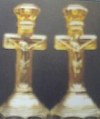Commemorative Lettered Pieces
COMMEMORATIVE LETTERED PIECES
As we approach this grouping of specialized pieces, you will see the delineation between these examples and the Advertising items, which will be discussed in another segment.
Commemorative Carnival Glass pays tribute to an event, place, building, bridge, etc. of significance. The souvenir-type glass items were given or sold as remembrances of that specific dedication in history.
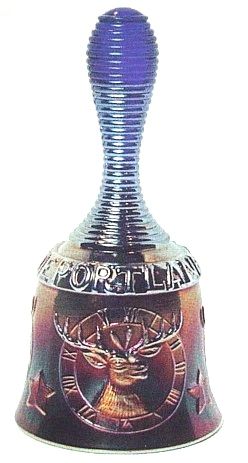 |
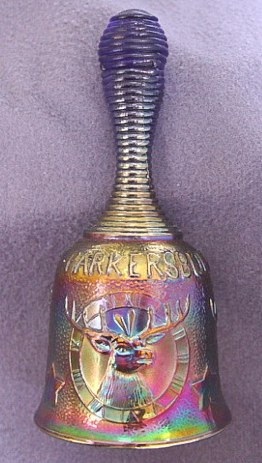 |
Portland 1912 Bell
|
Parkersburg 1914 Bell
|
PORTLAND BELL 1912 ~~ was found by an Indiana collector who placed it in an auction. A PA collector purchased it for $22,500 in July 1993. As of this writing, it remains the only one known. It is blue in color, and has the original chain/metal bead clapper (or did when last sold). Speculation has it that perhaps this was the sample made up for approval by the Elks committee for a planned convention, which did not materialize. We have seen, but not handled nor measured this bell, therefore can only presume it to be much the same size as the other bell designs. Fenton Origin.
PARKERSBURG BELL 1914 ~~ This 6” tall x 2 ¾” wide Elk bell is not plentiful by any standard. However, one surfaces occasionally, and always creates intense interest and bidding for ownership. Close examination reveals the hands on the clock face to be a part of the Elk antlers! We are natives of Parkersburg, WV, so it became important for us to gain one of these to go with our Parkersburg Elk plate. One summer, on a visit to see Dean's Mother, we made some inquiries around town, and discovered a gentleman in Belpre, OH (across the OH River from Parkersburg) who owned this one, and was (for a price), willing to sell. It has the original chain/metal clapper suspended from a tiny glass eyelet in the uppermost portion of the bell. The words “PATDAPPLD” ARE MOLDED INTO THE GLASS IN A CIRCLE AROUND THAT EYELET. (We keep a tiny piece of foam over the clapper to insure integrity of the bell.) Blue is the only color known. Color highlights tend to be more pronounced than on the Altlantic City bells. With a near-radium shiny finish, colors of gold, blue and green are prominent. Wording sequence offers city, organization and year. Fenton Origin.
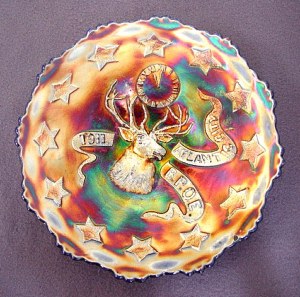 |
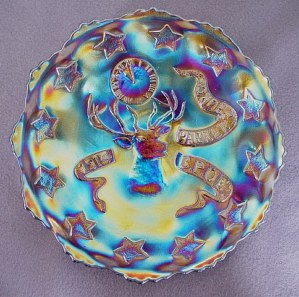 |
Atlantic City 1911
|
Parkersburg 1914
|
ATLANTIC CITY-ELK 1911 ~~ Again, the color is blue, known in IC shape bowl of 6 ½” and a 7 ¼” plate, both considered to be rare. The B.P.O.E. met there in New Jersey from July 10-13, called a “Grand Reunion” rather than a convention. Reports claim such attendance that filled not only the Strand Hotel, but surrounding hotels to overflow capacity. Daily functions were held outside on boardwalks and the Music Hall on the Steel Pier, which made Atlantic City famous. The plates tend to be slightly cupped-not nearly so flat as the Parkersburg versions. The bells sold for the same event are 5 ½” tall x 3 1/8” wide. The bottom flares more-so than does the base of the Parkersburg bells. Wording sequence offers city, year and organization. The topmost portion of these bell handles are not iridized. This is where the bell was held during application of the spraying process. Some of these Atlantic City bells have an indentation from the grasp of a tool while the glass was still warm. It should not decrease value or desirability. Plate and bowl have Wide Panel exterior. Fenton Origin.
PARKERSBURG PLATE 1914 ~~ B.P.O.E. CONVENTIONS were events to be remembered, as you are beginning to understand! These 7 5/8” blue plates are somewhat more available than their bell counterparts, but are still considered rare. These plates tend to have better iridescence than their counterparts-the Atlantic City examples. The “S” in Parkersburg is always reversed, apparently associated with difficulty in incising the letter into a mold. (This phenomena repeats itself in other lettered pieces.) Prices for great examples with distinct mould strike will fetch $2500 or more in recent years. Local Lodge #198 hosted this June 18-19 affair. Convention functions were conducted on the 18th. A parade maneuvered through downtown streets on the 19th , followed by a dance held at Terrapin Park, which had a large indoor pavilion. (Please see attached photo and description.) The Lodge still exists at 1515 Juliana Street. Fenton versions of these pieces always display the Elk looking to the viewer's right. Wide Panel exterior. Fenton Origin.
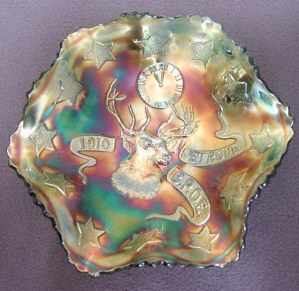 |
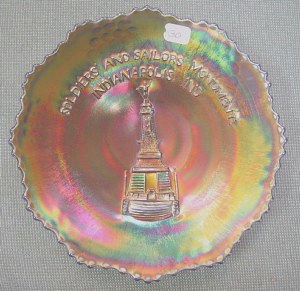 |
Detroit Bowl 1910
|
Indianapolis Soldiers & Sailors Monument Plate
|
DETROIT BOWL 1910 ~~  This convention was called the National Grand Reunion of the B.P.O.E., held at the Poncharpariam Hotel in Detroit, MI from July 11-15, 1910. Amethyst and blue bowls are rare. Rarest of all-marigold bowls were made. (One or two known). Green bowls should be considered very rare, if indeed, ANY of the bowls can be said to turn up with any frequency. They were made in IC shape and ruffled versions. Patience and fortitude are admirable personal traits when deciding to collect this phase of carnival glass. (There are l o n g dry spells in the process.) Finish on this green bowl is called Satin. Sales records indicate the amethyst and blue will sell for somewhat less. A rare green plate in this design brought $17,500 in 2001. Two green 7 ½” plates are known. An amethyst ruffled bowl in radium finish sold for $2200 at the 11/22/03 Seeck Auction in St. Louis. Wide Panel exterior - Fenton Origin.
This convention was called the National Grand Reunion of the B.P.O.E., held at the Poncharpariam Hotel in Detroit, MI from July 11-15, 1910. Amethyst and blue bowls are rare. Rarest of all-marigold bowls were made. (One or two known). Green bowls should be considered very rare, if indeed, ANY of the bowls can be said to turn up with any frequency. They were made in IC shape and ruffled versions. Patience and fortitude are admirable personal traits when deciding to collect this phase of carnival glass. (There are l o n g dry spells in the process.) Finish on this green bowl is called Satin. Sales records indicate the amethyst and blue will sell for somewhat less. A rare green plate in this design brought $17,500 in 2001. Two green 7 ½” plates are known. An amethyst ruffled bowl in radium finish sold for $2200 at the 11/22/03 Seeck Auction in St. Louis. Wide Panel exterior - Fenton Origin.
INDIANAPOLIS SOLDIERS AND SAILORS MONUMENT PLATE ~~ When there is only one known in a shape, such as in the case of this 7 ½” plate in blue, desire peaks at its emergence from a collection of long standing. This plate had belonged to Jack and Mary Adams. When their collection went to auction in St. Louis, Nov. 22, 2003, the selling price to a mail bidder was $15,500. (Item was #30 in the auction). It had previously sold during a Woody Auction in 1974 for $1500. Construction of the Monument was begun in 1889, to commemorate those fallen in battle during the Civil War. Dedication became a reality on May 15, 1902. Standing in the center of Monument Circle in downtown Indianapolis, this outstanding “work of art” matches ANY of the more famous monuments in the Nation's Capital. 285 feet in height, surmounted by a statue of Victory, visitors may ride the elevator, and then walk to the top for a view over the City. Historic records make mention of an undefined “gala celebration” which took place in Indianapolis during the summer of 1912. Perhaps this was the impetus for creation of this specialty piece? This item is obviously from the same mold blank as the Illinois Soldiers and Sailors, as well as the Indiana Statehouse plates, (both of which may be viewed in the site segment entitled: Companions of the Horse Chestnut ). Horse Chestnut OR Berry and Leaf circle exterior.
Historic Point: A re-enactment of a Civil War battle took place on site in Indianapolis - May 15, 2002 in celebration of the 100th Anniversary of this Monument. Fenton Origin.
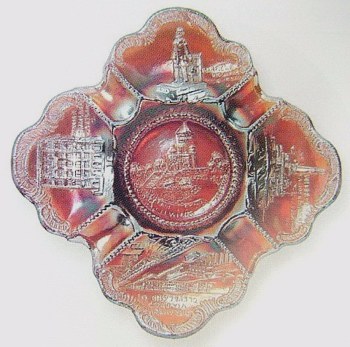 |
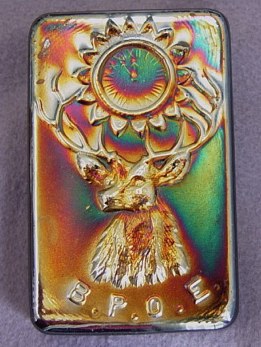 |
Cleveland Ashtray
|
Elk Paperweight
|
CLEVELAND ASHTRAY ~~ Emblems found on this unusual piece: Garfield Statue, Cleveland, OH; Chamber Commerce, Cleveland, OH; Garfield's Tomb, Cleveland, OH; Soldiers and Sailors Monument, Cleveland, OH; Superior's Viaduct, Cleveland, OH. A somewhat delicate piece of glass, it is amazing that even a few have survived in amethyst, claiming the very rare status. 3 or 4 marigold examples are known in this 6” ashtray. The accepted name of this tray appears no place on the item. Subject matter of the emblems has obviously created a generic name. History relates that the Cleveland Centennial occurred in 1896, before carnival glass had come into fashion. The Centennial of Incorporation took place in 1914, two years after Millersburg Glass Co. went out of business. The most likely scenario for producing these pieces was for use as souvenirs to be sold during the Cleveland Industrial Exposition in June of 1909. John Resnik notes in his Encyclopedia of Carnival Glass Lettered Pieces, published in 1989, that he spoke with an 89 year old gentleman who remembered his father purchasing one of these ashtrays at the Exposition! There is no exterior pattern. An amethyst ashtray sold 11/22/03 for $7000. Millersburg is the accepted manufacturer.
ELK PAPERWEIGHT ~~ Dimensions of 4 ¼” x 2 ¾” x 4 7/8” combine to make ¾ lb. of impressive glass. Estimates are that 20-30 amethyst paperweights exist, with at least half of those having some moderate damage. Of the two known green ones, one is damaged. Degradation of prices is incumbent upon the buyer when assessing the damage. Damage to our amethyst example shown here is about ¼” x ½” of epoxy on the bottom edge. The mould strike and iridization more than compensates! The elk faces to the viewer's left, designating this to be a Millersburg production. The B.P.O.E. emblem which encompasses an elks head with a clock face above indicating eleven o'clock, has ritual significance. Eleven PM is regarded by Elks to be a mystical hour; a time to remember and honor the dead. Elk functions observe a moment of silence at that hour. Unfortunately, the Millersburg moldmaker was confused with the big and little hands on the clock, and apparently unaware of the importance placed on eleven PM. ALL Millersburg Elks pieces have the clock set at five to twelve, rather than at eleven o'clock. No data confirms a designated function when this paperweight was available. However, an educated guess places it to be Detroit 1910. Since the only dated Millersburg Elk dates from the 1910 reunion, it more or less follows that this paperweight is from the same function. The brief time span of Millersburg operations also lends credence to this date.
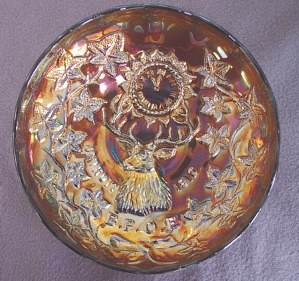 |
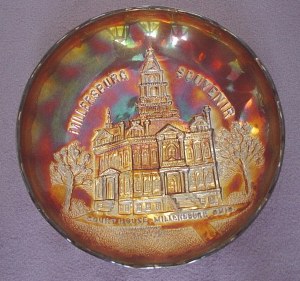 |
Elk - Detroit Millersburg
|
Lettered Millersburg Courthouse
|
ELK - DETROIT - MILLERSBURG ~~ For a description of the event, please see the first sentence in the paragraph called DETROIT BOWL-1910. This “two-eyed” Elk is a classic piece of Millersburg. Substantially more artistic in detail than its Fenton counterpart, it is always in radium finish, always beautiful! There is no evidence to support the theory, but supposition is that this design was sub-let from the Fenton factory. Possibly John Fenton learned of the event through family ties and decided to cash in on the opportunity. Both are very rare, with ruffled bowls of 7” bringing somewhat less than the ice cream shape. The round shape is not only more difficult to acquire, but certainly displays the pattern to better advantage. Desirability factor of the shape will create as much as a $500 differential in sale price. A ruffled version sold on 11/22/03 for $2200. In early Dec. '03, a crimped-edge bowl sold over E-bay in excess of $2500. Millersburg Elk pieces display the Elk looking to the viewer's left. Wide Panel exterior.
MILLERSBURG COURTHOUSE ~~ The story of these famous 7” bowls may not sound quite so preposterous by today's standards, following the recent abuses of the wall street giants against their clientele. Lucille Lowe of Killbuck, Ohio, a recognized Millersburg “authority” purported the “give away” story to be fact. Mrs. Lowe's grandparents were investors in the Millersburg factory, and she has lived her entire life in the area, so she certainly should have a command of the situation. She relates that John Fenton already knew of his impending bankruptcy, and produced these bowls to placate his investors! Reportedly, 1000-1500 were made for the express purpose of giving them away. The building displayed in the design is the third in a series of courthouses built in Millersburg, completed in 1886, and continues to be in daily use. The twenty-fifth anniversary of this courthouse would have occurred in 1911, at a time when the Millersburg factory was still in production. There are several ruffled varieties known, along with an unlettered version. This presumably was an omission in the original mold, corrected following a short run. The lettering: COURTHOUSE, MILLERSBURG, OHIO found at the base of the building is missing on the unlettered pieces. One of these unlettered bowls brought a cool $4000 at the 11/22/03 Seeck Auction! Any of the shapes/types should be considered scarce.
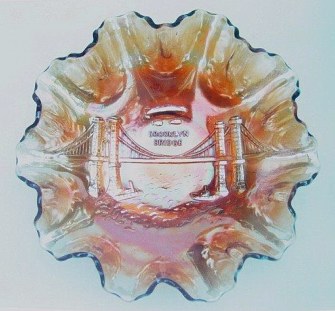 |
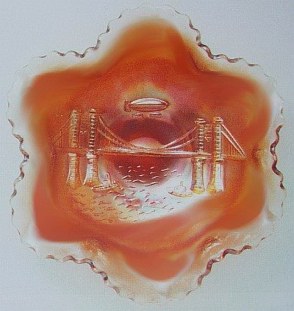 |
Lettered Brooklyn Bridge
|
Unlettered Brooklyn Bridge
|
BROOKLYN BRIDGE ~~ When John Resnik compiled his information on lettered pieces, mention was made that no shards had ever been found for these 9” bowls. Carl O. Burns states in his fine book about Dugan/Diamond examples that quite possibly this was one of the last of the Diamond production before their destructive fire in 1931. Reports indicate that a large quantity of the bowls was found and distributed to townspeople following the fire cleanup. Some bowls have six, some eight, and others have ten ruffles. Marigold is the only known color, not considered rare in the usual version displaying the letters “Brooklyn Bridge”. However, there are perhaps only two-three examples which lack the lettering. These must be considered extremely rare. One of this type bowl sold over Ebay in 2002 for several thousand dollars. By 1930-1931 airship travel had become the rage, with regularly scheduled flights between the US and Europe. Speculation maintains that these bowls were produced in anticipation of the 50th anniversary of the famous bridge in 1932. This would explain the quantity found in storage following the 1931 fire. Since examples are known in pink, having marigold iridescent overlay, the design was surely a part of the Diamond After Glow line. After Glow provided pastel pink and green base glass, some iridized, some not. The line was introduced in the 1928 time frame, again confirming that Brooklyn Bridge bowls were in production prior to the 1931 fire. After Glow is found in several well-known Diamond carnival patterns.
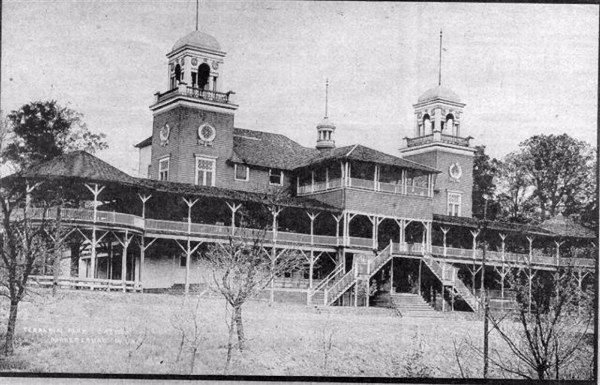
Terrapin Park Casino
AN IMAGE OF YESTERYEAR
They just don't construct buildings like this anymore do they? The “charm” of such buildings continues to conjure up pleasant memories even today, as we consider the happy times once experienced in such as this place. This lovely old structure is the Terrapin Park Casino. Terrapin Park was located in Parkersburg, WV., about 12 miles south of the Fenton Glass factory. At the time this photo was taken at the turn of the century, casino was a term meaning multi-purpose auditorium. Dean's Mother, an accomplished jazz pianist, born in 1896, played piano with a band performing here on weekends when she was a young lady.
This photo appeared on a postcard of the period. Information thereon describes: “The casino was the central point of the park and was built in the spring of 1899 and destroyed by fire in August 1917. The building cost $15,000 and required 250,000 feet of lumber to build. Other attractions at the park included a roller coaster, merry-go-round, fun house, roller skating rink, bowling alley and an artificial lake.”~~~ The above was submitted to Antique Week in Sept. 1999 in pursuit of additional information for a book being formulated on Terrapin Park by Jeff and Christy Little, 1212 Washington Ave. Parkersburg, WV 26101.
As late as the early 1940's, long after the Casino fire, Terrapin Park continued to be used for family picnics, and hiking. The brother of Mrs. Fry lived across the street from the Park. Dean remembers playing along the wooded Park trails as a 10 yr. old, while the adults visited. After WWII, the area was developed for housing.
Commemoration of events as called for in the production of these specialty items amid Carnival Glass, has memorialized segments of history in such a beautiful manner that we continue to prize their presence in our midst. Loving admiration for their significance is evident. The lovely old structures of that time in history have, for the most part departed from the scene, but with nurturing and concern for another generation of interested collectors, we can impart our love for the Glass into the future! What do you say? Let's “have a go!” There is an element in human nature which calls for preservation of the past. Perhaps it is a manner of self identification.
Dean & Diane Fry~~~1/04
Whoever loves instruction loves knowledge,
But he who hates correction is stupid. ~~ Proverbs 12:1
“Only Angels Can Wing It.”
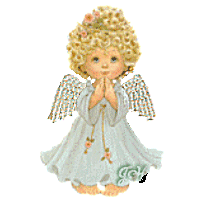
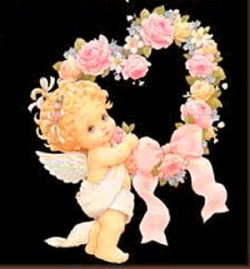

Should you care to contact the Frys, their email address is:
Search Our Sites
back to Carnival Glass 101
Our other sites you may enjoy:
Everything you EVER wanted to know about Indiana Glass
Great Reference for Newer Carnival Glass.
Complete Glassware Catalogs Available to Download
Questions? Comments? Suggestions? Broken Links? Corrections?
Your Friendly Webmaster is here to help!
